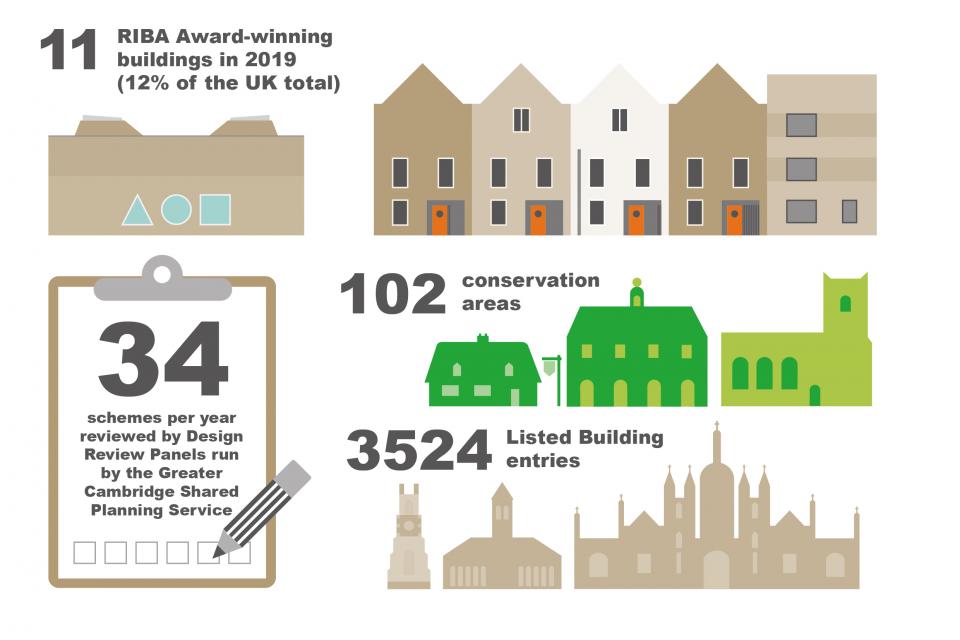
In response to the First Conversation consultation you told us that ’s should ensure high quality design and make great places that people enjoy, by enhancing local landscapes and raising climate ambition, while sensitively responding to the historic environment.
Aim for our Great Places policies
Sustain the unique character of Cambridge and South Cambridgeshire, and complement it with beautiful and distinctive development, creating a place where people want to live, work and play.
How has this influenced the shape of the plan?
Maintaining and creating great places is crucial to sustaining the quality of the area for people who live, work, study in, and visit . Great places are valued and distinctive, accessible to all people and well-integrated with nature. Valuing place in this aims to ensure that all residents’ quality of life in ’s can be improved while enhancing the global excellence of its knowledge economy and the preservation of the area’s heritage assets. A place-centred approach can help meet the diverse needs of different communities to enable to retain and attract global talent and ensure that new development responds to local needs.
The covers an area that is both urban and rural, and the proposed spatial strategy aims to support the individuality and distinctive qualities of Cambridge and the surrounding villages both large and small. Across each policy area proposed, the plan sets a priority for delivering high quality and well-designed places to enable new development that responds positively to the existing context and contributes to creating and maintaining high quality design of the natural and built environments that combine to form great places. Design quality that responds to community and climate needs, establishes new connections, preserves and enhances ’s character, heritage and natural assets will be key in reconciling ’s planned development and helping to meet the significant challenges of the climate emergency and growing inequalities.
There are many different aspects that combine to help create the character and quality of places. Design matters will be informed by physical, social and economic considerations that together influence the quality of any proposal. Since 2008, the Councils have been using the Cambridgeshire Quality Charter for Growth to provide a clear and consistent basis for helping to secure a common expectation for the quality of our new developments. Themes covering the four ‘C’s’ of Community, Connectivity. Climate and Character have been used to provide an understanding of what needs to be considered when creating and assessing high quality design. The overlaps between the themes are equally important and allow judgements to be made that go beyond pure ‘aesthetic’ considerations. Given the strong track record of delivering high quality design in the area, evidenced through award winning schemes and overall growth delivery, the themes from the Charter have been used to structure policies in the Great Places chapter. Such an approach is consistent with the National Planning Policy Framework, the , and National Model which identifies Climate, Character and Community as part of the identified ten characteristics of well-designed places.
How does this intersect with the other themes?
Great places are underpinned by all of the ’s themes. A great place is somewhere that:
- reduces embodied and operational carbon requirements, and adapts over time to support low carbon lifestyles;
- nurtures biodiversity and the delivery of green spaces to enable nature to flourish;
- fosters wellbeing and inclusion by ensuring that all developments and public spaces are safe and accessible;
- supports a work life balance by enabling employment to be conveniently located to residents;
- delivers homes to meet all people’s needs and locates them conveniently to services and amenities; and
- ensures that infrastructure is delivered coherently in a way that is integrated with place.
Topic paper
Further information on the policy areas, including their national, regional and local context, and further information on the evidence that has informed the proposed policy direction, can be found in the topic paper which accompanies this theme:
- : Topic paper 5: Great Places
Tell us what you think
Our consultation for this phase is now closed.
What policies are we proposing?
The following policy areas have been identified under this theme: